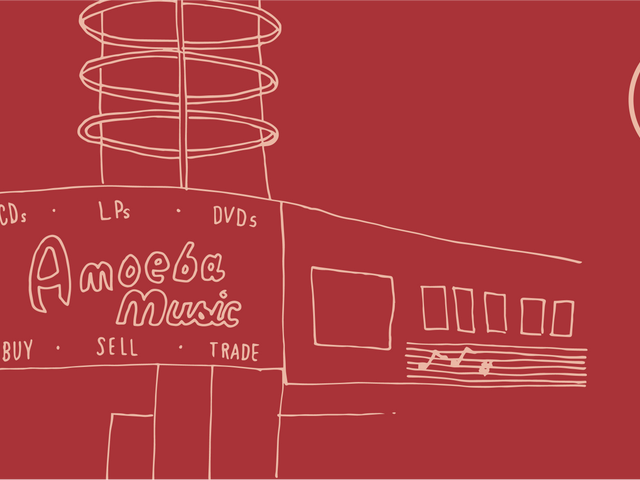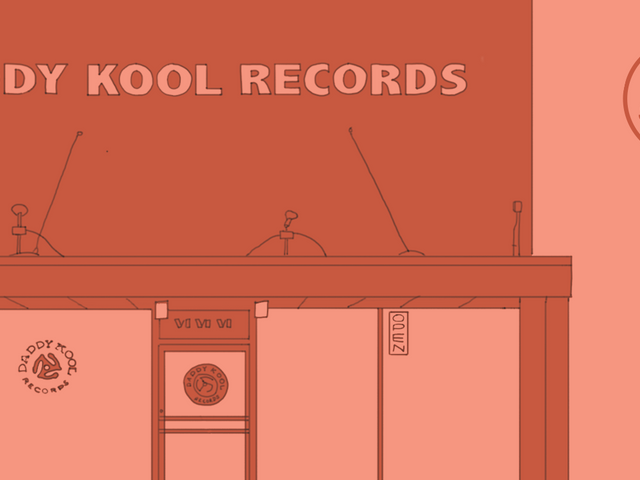Shangri-La Records je nejlepší obchod s deskami v Tennessee
50 nejlepších hudebních obchodů v Americe je série esejí, kde se snažíme najít nejlepší hudební obchod v každém státě. Tyto obchody nejsou nutně ty s nejlepšími cenami nebo nejširším výběrem; k tomu můžete použít Yelp. Každý hudební obchod, který je zde uveden, má příběh, který přesahuje to, co mají na svých policích; tyto obchody mají historii, podporují smysl pro komunitu a znamenají něco pro lidi, kteří je navštěvují.
Toto je příběh o Shangri-La Records – ale je to také příběh o městě, které udělalo z obchodu to, čím je.
Jako město je Memphis zodpovědný za vrhání některých z nejšpinavějších košil historie do přeplněného koše špinavého prádla jihovýchodní části. Před občanskou válkou byl regionálním centrem pro domácí obchod se sluhy a ekonomickým centrem odvětví, které ziskově těžila z otroctví - a během rekonstrukce, obzvláště notoricky známým místem rasových nepokojů. V 70. letech 19. století sérií epidemií žluté zimnice bylo zničeno většina populace města, což stálo Memphis jeho městskou chartu a přimělo jeho občanské vůdce izolovat jeho nejchudší, nemocné občany do uprchlických táborů. V počátku 20. století a dále Memphis zdokonalil autoritářskou politiku pod E.H. „šéfem“ Crumpem, zanedbával chudé a bezprávné a zneužíval své černé občany. Je to plný bingo karet všech občanských a sociálních problémů, které místo může mít.
Avšak jako tolik velkých měst obklopených většinou ničím, Memphis představoval cestu ven a způsob, jak se posunout vpřed pro lidi v regionu: místo, kde se zdálo možné projít bránou, nebo najít způsob, jak se sám stát vrátným - obě strategie byly stejně závislé na budování a udržování podpůrných komunit. Memphis nikdy nebylo jednotným městem, ale vždy bylo místem, kde boj přináší solidaritu - charakteristika hluboce vnitřně spojená s hudební komunitou města téměř v každém historickém okamžiku.
Skutečný důvod, proč je hudba, kterou spojujete s Memphisem, tak dobrá? Je to proto, že nebyla nadměrně kontrolována korporátními vkusem nebo zájmy. Tolik z toho se odehrálo organicky, vycházející z komunit, které pracovaly, stal se tím, protože hudebníci, kteří se dostali na vrchol žebříčku, se otočili, aby pomohli ostatním. Rufus Thomas se stal DJem na WDIA a moderátorem v Palace Theater na Beale Street a využíval svou moc k propagu BB Kinga a Bobbyho „Blue“ Blanda. Jim Stewart, spoluzakladatel Stax Records, dal řidiči Otisi Reddingovi šanci nahrát píseň. Hudebník a spoluzakladatel Goner Records začal kariéru Jaye Reatarda poté, co obdržel jeho demotape poštou. Objevení se v písni Three 6 Mafia se stalo kariérním katalyzátorem pro téměř každého memphiského rappera, o kterém jste kdy slyšeli. Atd. Atd. Atd.
Toto neznamená, že každý vždy měl jasnou a stejnou šanci na úspěch - ale v městě, kde byly Sun a Stax otevřeny amatérům a celá ulice dominovaná podniky vlastněnými černými obyvateli byla jednou obrovskou jam session noc co noc po desetiletí, šance na objevování začínají být o něco lepší. Městským spasitelem byla vždy jeho kultura - a spasitel této kultury je, že je postavena shora dolů, nikoli shora dolů.
Jak dlouho Memphis existuje, bylo mnoho toho, na co může být hrdé a co je také hanbou. Avšak s bohatou tkaninou nových problémů, které se objevují v letech po atentátu na Dr. Martina Luthera Kinga na městě Lorraine Motel (víte, o čem mluvím; nejsou unikátní pro Memphis: bělošský únik a s tím související únik zdrojů, a léta a léta sociálních a ekonomických následků, které taková situace vytváří), když jsem žil v Memphisu na začátku 2000s, mluvili Memphiské o tom, čím město bylo spíše než tím, čím by mohlo nebo mělo být. V té době sdílely kulturní atrakce města stejný postoj a představovaly Memphis zachovaný v jantaru, jako by jeho hudba přestala existovat nebo přestala vyvíjet se po 70. letech, i když Memphis zůstával místem, kde umělci a hudebníci mohli prosperovat v rámci možností a v podpůrné komunitě. Tento postoj otrávil způsob, jakým město vnímali návštěvníci i obyvatelé - a přivedl Memphis po nejhorší a nejméně produktivní cestě: nechat truchlení po tom, čím byla, definovat jeho přítomnost.
Memphis se stal městem, které si samo sebe strašilo. Jak najít cestu vpřed, když se neustále díváte zpět? Jak uctít to, čím jste byli, aniž byste to obtěžovali to, čím byste mohli být? Naštěstí, nejlepší obchod s vinylovými deskami ve státě měl - a stále má - několik odpovědí pro Memphis.

Shangri-La Records letos oslaví 30. narozeniny a je výjimečný ve všech nejzřejmějších měřítkách, která byste mohli použít k měření velikosti obchodu s deskami - přátelský personál, hluboký inventář, eklektické nálezy nejsou těžké najít, koupí desky vaší babičky, pokud jsou v dobrém stavu - ale její nejlepší vlastnosti jsou soustředěny ve všech způsobech, jak je tak důkladně z Memphisu. Skrytý uvnitř domu, který je více než století starý, jeho excentrický zakladatel Sherman Wilmott původně zamýšlel, aby Shangri-La byl něco jako lázně pro ty s hliníkovými klobouky, vybavený nádržemi pro sensory deprivation flotation a brýlemi, které pulsovaly světla ve vašem periferním vidění připojené k sluchátkům, která hrála uklidňující muziku. Je možné, že by to nyní mohl být legitimně životaschopný podnik, ale zpátky v 80. letech jsme všichni byli méně úzkostliví a neschopní kupovat krystaly na Etsy jako náhradu za vyvíjení skutečné osobnosti, takže Wilmott dostal jediný přepravník desek a přeměnil ho na obchod.
V roce 1999 Wilmott opustil Shangri-La, aby se stal prvním kurátorem Stax Museum, předal opratě hudebníkům Jaredovi a Lori McStay a majiteli Misspent Records Johnu Millerovi, z nichž tři stále společně řídí obchod dnes. Ale zatímco vedl Shangri-La, Wilmott nastavil tón jeho vztahu k městu. Funkcionoval poněkud jako jednočlenná podzemní turistická kancelář a kulturní šampion pro Memphis, ukazoval návštěvníkům, kteří si stěžovali, že jim došly věci na zábavu, na atrakce z méně navštěvovaných míst jako je místo narození Arethy Franklin v Jižním Memphisu, samonákladně publikoval průvodce s názvem Kreature Comforts: A Low-Life Guide to Memphis a dokonce organizoval Ultimate Memphis Rock N Roll Tours (nejprve z jeho vlastního dodávky, poté v legitimnějších prostředích). V 90. letech, když objevil, že v městě žádné obchody s deskami nenosí desky produkované nezávislými labely z Memphisu - což znamená, že spotřebitelé neměli přístup k albumům, která se vyráběla pár bloků od jejich domova - Shangri-La začal nosit vydání jako importy, což motivovalo hudebníky, aby nahrávali a vydávali svou hudbu v Memphisu, protože měli místa, která je podpoří.
Kromě toho, že se stará o místní hudebníky, Shangri-La vždy měla zaslouženou reputaci najímat hudebníky a hudební kritiky, aby pracovaly v obchodě, pomáhala místním kapelám propagovat jejich koncerty a vytvářet příležitosti pro kapely vystoupit v obchodě, včetně dvou každoročních hudebních festivalů, Sweatfest a Purgefest (výstižně pojmenovaný druhý festival také plní účastníky tisíci levnými deskami na prodej - jděte, je to úžasné). Wilmott dokonce založil label a nakladatelství, Shangri-La Projects, které stále úspěšně pokračuje, aby dal memphiským hudebníkům další kanál pro to, aby dostali svou práci ven a aby dělali být hudebníkem v tomto městě co nejvíce finančně životaschopným. Je to label v byznysu oslavovat všechno, co Memphis má nabídnout, od děsivě obšírných kompendií garage rocku po soundtrack oceňovaného dokumentu Memphis Heat: The True Story of Memphis Wrasslin’, obsahující hudbu nahranou speciálně pro film (film, který sám Wilmott spoluprodukoval, a měli byste se na něj podívat).
Shangri-La už dávno zjistila, jak dělat to, co tolik jiných memphiských institucí nyní zjišťuje: rozbít vlastní dočasné hranice města a současně oslavovat to, čím Memphis kdysi byl, ukazovat, čím je dnes a pomáhat utvářet to, čím se město stane.
Tohle by byl lepší text, kdybych měla víc působivých příběhů o lovení desek v Shangri-La, které bych si mohla s vámi sdílet, ale žila jsem poblíž obchodu v době svého života, kdy to zkrátka nebyla pravda. Odešla jsem z východního Tennessee v roce 2001, abych šla na vysokou školu do Memphisu a pak se v roce 2007 přestěhovala do Chicaga, takže většina mých zkušeností s nakupováním v Shangri-La proběhla mezi 18 a 24 lety.
Čtenáři, nebyla jsem „cool“ mezi 18 a 24. První počítač, který si moje rodina kdy koupila, byl notebook, který jsem dostala na vysokou školu - takže i když jsem byla posedlá hudbou, nedostatek přístupu znamenal, že moje pracovní znalosti hudby nikdy nedosáhly úrovně mé posedlosti. Hltala jsem hudební časopisy, ale příležitosti poslouchat to, o čem jsem četla, byly těžko k nalezení: mohla jsem to slyšet v rádiu nebo MTV náhodou, doufat, že to, co vzbudilo můj zájem, bylo něco staršího, co bych mohla najít ve sbírce desek svých rodičů nebo si půjčit v knihovně, nebo utratit jakékoliv peníze, které jsem ušetřila, za předraženou kazetu nebo CD. Naučila jsem se o spoustě hudby, kterou jsem nikdy neměla možnost slyšet, a můj písemný seznam alb a umělců, které jsem si slíbila zkontrolovat, kdykoliv budu mít šanci, zaplnil stránku po stránce.
Vysoká škola představovala příležitost pít z požárního hydrantu. Poprvé v životě jsem měla přístup k internetu doma; Napster, Kazaa a Limewire všechny prožily své mayské životy během mých pozdních teenagerství a raných dvaceti; žila jsem ve velkém městě s hlubokými vazbami na hudební historii, místní hudební scénu a několik nezávislých obchodů s deskami, které tam nebyly jen proto, aby vám prodávaly, co jste slyšeli v rádiu. Shangri-La byl ten nejbližší, kde jsem žila, a nejlepší.
Bylo to místo mnoha náhodných a záměrných prvních. Obchod byl místem, kde jsem poprvé slyšela Guided By Voices („Watch Me Jumpstart“ hrálo v ozvučení a okamžitě jsem koupila Alien Lanes) – a také místem, které mi pomohlo vyvinout trvalou lásku k britpopu poté, co jsem se zamilovala do kluka, který byl do toho opravdu zapálený (kluka jsem nedostala; dostala jsem spoustu alb od Pulp). Shangri-La byl také můj vstup do místní hudební scény mého nového domova, místo, kde jsem se dozvěděla o Alicji Trout a River City Tanlines, Reigning Sound, Oblivians, Harlan T. Bobo, The Reatards - o všech těchto memphiských hudebních skupinách, o kterých jsem nikdy předtím neslyšela, ale které se okolo mě odehrávaly. Ptala jsem se personálu obchodu na jejich kapely a na kapely, které milovali, a pak jsem šla je zkontrolovat na místech kolem města. Viděla jsem kapelu v Hi-Tone a pak jsem šla do Shangri-La druhý den a koupila toho, koho jsem slyšela. O několik let později na své první postvysokoškolské práci jako koordinátor akcí v Centru jižní folklóry bych zarezervovala kapely, o kterých jsem se poprvé dozvěděla od někoho v Shangri-La. Cítila jsem se jako součást něčeho, blaženě uvězněná v těch samých jemných vláknech, které spojovaly umělce v tomto městě, a za to musím poděkovat Shangri-La.
Krátce po loňském Dni díkůvzdání, jsem byla #požehnaná mluvit s aktuálním majitelem Jaredem McStayem o obchodě a o Memphisu, a on řekl něco, co bylo velmi pravdivé a zůstalo se mnou: „Pokud jsi hudebník v Memphisu, vždy bylo těžké dostat Memphiany, aby podpořili, co děláš, dokud nedostaneš nějaké národní uznání. Potřebuješ externí validaci, než ti lidé tady budou věnovat pozornost.“
Skutečně, Memphis strávil posledních několik let v příjemné zpětné vazbě s národním uznáním a sebedoceněním na opačných pólech. Korporátní a kulturní instituce města nyní pravidelně používají drsnost, teplo a excentricitu Memphisu jako reklamu - a i když není nic horšího, než když se značka chytí něčeho pravdivého a skutečného a strip-minuje veškerý jeho význam, prozatím je osvěžující vidět město oslavovat to, čím je dnes, místo toho, čím bývalo, přivlastnit si identitu zcela unikátní pro Memphis a sledovat, jak se nejlepší kvality města přetvářejí obvykle nudné věci, jako je fanouškovství NBA, na něco úžasného. A nemohu si představit, jak by se Memphis dostal na tuto úroveň bez takových podniků, jako je Shangri-La, které každý den tvrdě pracují, aby město zlepšili a pomohli městu vidět to nejlepší v sobě.
Veřejně řečeno, v současnosti není praktická potřeba, aby obchody s deskami existovaly. Můžete streamovat 30 milionů písniček ze svého telefonu; můžete si objednat jakýkoliv fyzický produkt, který chcete, z pohodlí vašeho gauče a nechat si ho doručit až k vašim dveřím. Z čistého nostalgie stranou, raison d'être obchodů s deskami v roce 2018 je role, kterou hrají při připomínání nám, že hudba má sílu vytvářet a udržovat komunity - že sdílená úcta k písni může začít přátelství, změnit život, vyvolat hnutí. To je hrdé dědictví a pravděpodobná budoucnost Memphisu. Je to moje představa o Shangri-La - a to je Shangri-La Records.
Hned poté se vydáváme do obchodu s deskami v Kalifornii.
Susannah Young is a self-employed communications strategist, writer and editor living in Chicago. Since 2009, she has also worked as a music critic. Her writing has appeared in the book Vinyl Me, Please: 100 Albums You Need in Your Collection (Abrams Image, 2017) as well as on VMP’s Magazine, Pitchfork and KCRW, among other publications.



